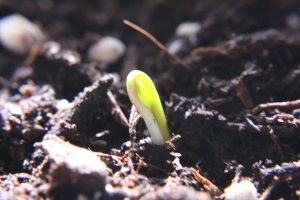If You Don’t Like What You’re Harvesting, Pay Attention to the Soil
Life on the entire planet depends on healthy soil to create and sustain the necessary matrix for life. Similarly, good life in any human community requires healthy cultures that contain the nutrients for desirable elements to grow and flourish and that discourage the growth of undesirable elements.
Growing religion is not among the stated purposes of the United States. From the point of view of the Constitution, religion is not a crop the government is supposed to grow. However, from the point of view of the Constitution, religion provides a potential soil nutrient for the thriving of democracy and public life.
Let me unpack these claims.
Soil
Without healthy soil, life on earth as we know it would cease. A teaspoon of healthy soil contains up to a billion microorganisms. Yes, a billion. In addition to microorganisms, healthy soil is composed of minerals, organic materials, air, and water.
There is a movement today among some farmers and gardeners to practice regenerative agriculture because of the amount of death with which industrial agriculture has toxified the soil. Regenerative agriculture pays attention to a longer calendar and the health of the soil instead of measures such as crop yield in a given year. The heavy use of petroleum-based chemicals to “enhance” soil in order to increase yield will, over time, kill or nearly kill the soil. Farmers practicing regenerative agriculture work to regenerate the health of the soil, which in turn increases the health of everything and everyone that depends on that soil.
Healthy soil does a lot of work. It composts dead animals and plants and turns all of us back into the building blocks of life for something or someone else. Healthy soil grows plants that sequester carbon. That means plants draw carbon from the atmosphere and send the carbon into their roots. The looser the soil, the deeper the roots, the deeper the carbon is sequestered (some scientists think re-planting deep-rooted grasses—NOT the kind we grown on lawns in the U.S.—can reduce global warming significantly).
A soil’s total ecology creates the hospitable environment for all kinds of plants, desirable and undesirable. But establishing a good crop of healthy plants in healthy soil makes it more difficult for undesirable plants to invade. Still, the farmer needs to watch…
Culture
Culture is a term we give to the webs of meaning human beings weave to assign value to life. Culture is the communication-ritual-story-meaning-spirit-soul dimension of a family, group, organization, or society.
Human beings are social animals; we require care from and interaction with other human beings, over a long period of time, in order to develop into a healthy human being, into a person. Relationships with caregivers are essential for human development, but culture is essential, too. There is no human life without culture, and healthy cultures create and sustain life worth living.
Culture as Soil
Culture is like soil. Cultures are complex biosystems. There are healthy, life-giving cultures and there are death-dealing and nearly dead cultures. There are cultures full of nourishing plants in which a wide variety of people thrive, and others invaded by noxious elements with much death and few who thrive.
Some cultures benefit from composting the past and allowing the new to grow. Some cultures would benefit from a lot of compost.
Imagine that every culture is an ecology that encourages the growth of some “plants“ (ideas, movements, practices, moral values, and institutions) and discourages others.
Which crops are we trying to grow in the culture of the U.S.?
If we call to mind the Declaration of Independence, we might say we want to grow life, liberty, and the pursuit of happiness. But since “life” is an all-encompassing word, let’s say the Declaration of Independence names liberty and the pursuit of happiness as two plants to grow in American cultural soil.
Then, the Preamble of the U.S. Constitution might add these social virtues to liberty and the pursuit of happiness: a more perfect union, justice, domestic peace, security, the general welfare.
All these are the intended American “crops,” according to our better angels.
If these are the crops the U.S. cultural soil is designed to grow, then consider the nutrients and protections necessary for these crops:
- families which, with the aid of other organizations, have the ability to form responsible, self-governing persons who also thrive in relationships;
- particular practices of democracy, such as free and fair voting and elections, and offering an informed electorate valid and healthy choices;
- an economy that encourages both wealth and relative equality;
- robust education for an informed electorate, for the pursuit of happiness, and for a well-trained workforce;
- a quality of public conversation and argument sufficient to deal with differences, conflicts, and challenges;
- sufficient social cohesion;
- the moral and legal guardrails, evenly applied, to encourage some behaviors and discourage others;
- institutions to support health and well-being;
- adequate safety and protection from enemies, foreign and domestic.
One might also imagine some weeds and toxins that might invade the soil and undermine desirable crops, such as:
- public leaders giving encouragement to white supremacists and other political/social positions once considered “extreme;”
- the potential of gun violence, at any time, in homes, workplaces, schools, and in other public spaces;
- hidden and suppressed histories of violence and injustice;
- disease;
- fear, amplified and promoted by turning people and ideas and change into enemies;
- tipping “liberty” rights to privilege particular groups and interests (such as religious free exercise rights trumping all other rights) with no concern for mutuality, and in a time span that privileges “today” rather than also considering “posterity” (such as considering the energy base for today’s economy);
- a strictly punitive criminal justice system.
What About Religion?
I did not include religion either as a crop or as a soil element. Which is it, in the U.S. polity? The answer depends on one’s point of view.
From the point of view of the Constitution, religion is not a crop, or certainly not a crop with the prominence of justice, general welfare, and liberty. Growing religion is not among the stated purposes of the United States.
However, from the point of view of the Constitution, religion has a role as a potential soil nutrient. It may feed the American cultural crops and thus profoundly affect the nutrient value and the taste of those crops—negatively or positively.
Imagine what justice, liberty, domestic tranquility, or common defense looks like if fed by a “punishing god” religion rather than a “loving god” religion.
Imagine what a religion that promotes the exploitation of any and every natural resource (human beings have dominion, so “drill, baby, drill”) adds to the soil, as compared to a religion that treated the earth as a divinely blessed miracle and home for life as we know it.
If, constitutionally, religion is a nutrient, then religion can influence the taste and nutritional value of a crop but cannot itself be a government-grown crop. In fact, the more a Constitutional crop looks like a particular religion, the closer to an established religion that crop becomes and, therefore, the more protests will arise against that crop.
But there is another point of view. From the point of view of religion, religion may be its own plant and requires a friendly ecosystem in which to grow. Religion seeks free exercise, meaning a cultural soil ecology that allows the religion to flourish, either by leaving it alone to form its own fenced gardens (think Amish) or by encouraging the nutrients and plants and discouraging the seeds and toxins that are incompatible with the religion. In this perspective, public spaces must be made hospitable to the particular religion. One might interpret the current controversies in which religious liberties are asserted (refusing service, eluding the contraception mandate of the Affordable Care Act) and the appointment of religiously conservative judges and justices as efforts to change the cultural ecology, to plant religious crops and provide the soil necessary for those crops to flourish.
Two Conclusions
One. If we are not getting the crops we want or need, then we need to pay close attention to the soil. Is the cultural soil healthy? From my point of view, no, the cultural soil is full of toxins, low on its ability to recycle death into life, and choked with invasive plants. In the U.S., we are harvesting the public life and the democracy that we’ve planted, that have grown in soil hospitable for the harvest—and not in soil that is able to grow a multicultural, shared-power, democracy that can deliver on America’s promises for the vast majority of citizens and guests.
Two. We religious and spiritual types should pay closer attention to the nutrients and toxins our religions are providing to the soil. We are responsible for what we contribute, and we have contributed both nutrients and toxins. We should work on the side of those who are trying to regenerate this soil into a culture that grows the public virtues of the Declaration and the Constitution for all America’s people, and care less about rendering the soil fit primarily for us.
Photo Credit: Image by iwannadance is licensed under CC BY-SA 2.0



Leave a Reply